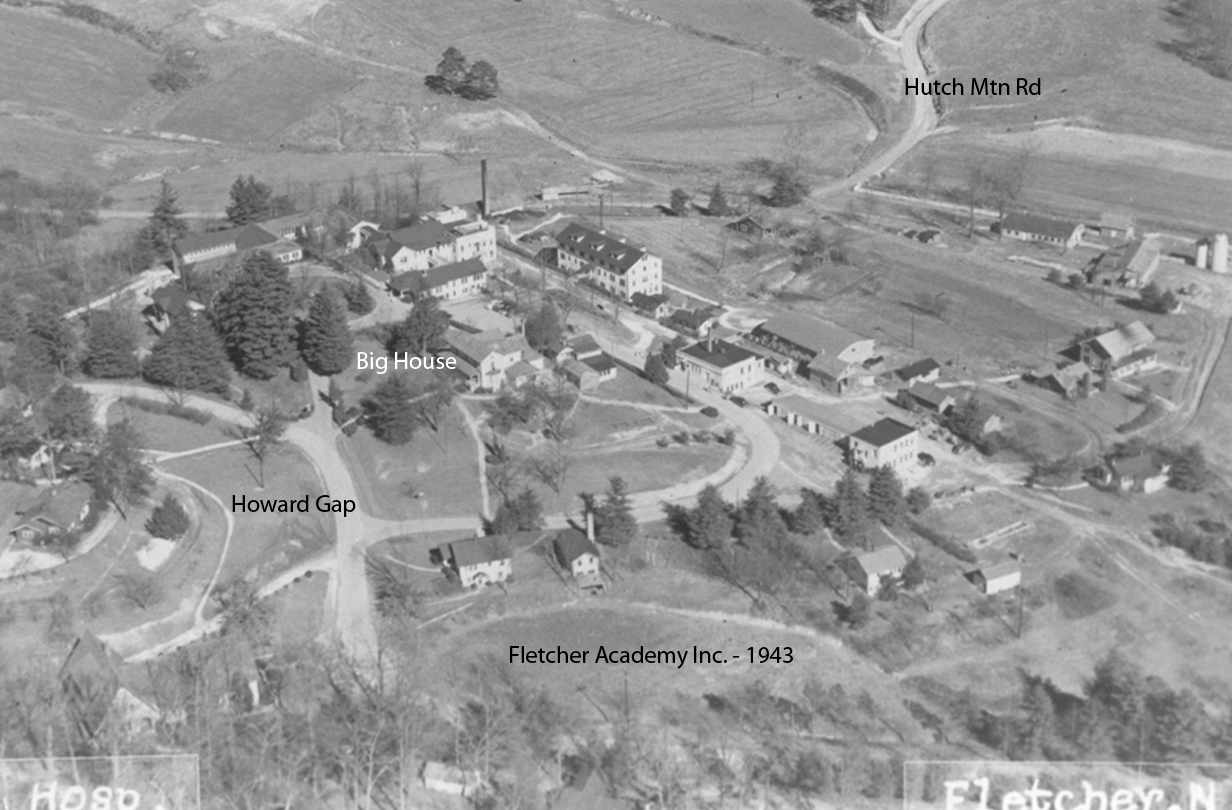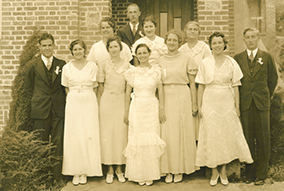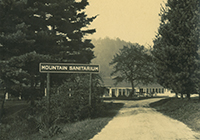For over a century, Fletcher has been building its history. Many lives have been changed on these grounds through the dedication of godly men and women who were sold out to Christ and His ministry to the youth. We encourage you to read the book “The Fletcher Story” for a thorough account of this institution’s rich history.

Fletcher Pioneers
Ellen G. White (1827-1915) – Visionary Spiritual Leader
More than a century ago, Ellen G. White inspired and guided the foundation of many Adventist educational institutions. Based on the Bible and her teaching, the core Adventist philosophy has become that education should be redemptive, for the purpose of restoring human beings to the image of God. Ellen G. White championed the now widely used “whole person” approach to education that encompasses mental, physical, social, and spiritual health, intellectual growth, and service to humanity.
In 1904 Mrs. White was one of the founding members of the Nashville Agricultural Normal Institute, later named Madison College. It was formed as a self-supporting institution but closely allied to the Seventh-day Adventist Church. It would grow to include a school (grades 1–16), a sanitarium-hospital, and a farm of more than 800 acres. This became the only time where Mrs. White agreed to officially be a member of a board of trustees. The goal was to have a school whose doors would swing open to any young man or woman of worthy character who was willing to work. A large tract of land was needed to provide facilities for this student self-support. The training here would include not just ordinary book studies, but also how to solve practical problems having to do with daily life. Nearly 40 small outpost schools and centers were started from this model.
In 1909, at the age of 81, Mrs. White made the long trip from her home in California to Washington D.C. While her chief purpose was to attend the quadrennial session of the General Conference of Seventh-day Adventists, she also made it a point to stop by Nashville and encourage the faculty and staff as well as at several other Adventist schools and colleges.
Along her journey, Ellen White preached in Asheville, NC, and was able to meet for the first time, Martha Rumbough, the daughter of a successful inventor. Sister Rumbaugh was studying to become an Adventist but had already built and given to the conference a commodious meetinghouse and parsonage. She was also personally supporting the pastor of the Asheville Church at a salary of four dollars per week. During the visit, Mrs. Rumbough asked Mrs. White, “What more can I do with my share of my family’s wealth to further the cause of God locally?” Mrs. White answered in the familiar and oft-quoted words, “the Lord would be pleased if you would start a medical and educational work in the vicinity of Asheville.” The next year Mrs. Rumbough would provide the money for the initial purchase of the property in 1910 that would later become Fletcher Academy and Park Ridge Health.
Ellen White was a woman of remarkable spiritual gifts. During her lifetime she wrote more than 5,000 periodical articles and 40 books. She is the most translated woman writer in the entire history of literature, and the most translated American author of either gender. Her life-changing masterpiece on successful Christian living, Steps to Christ, has been published in more than 140 languages. Her writings cover a broad range of subjects, including religion, education, social relationships, evangelism, prophecy, publishing, nutrition, and management. Seventh-day Adventists believe that Mrs. White was more than a gifted writer; they believe she was appointed by God as a special messenger to draw the world’s attention to the Holy Scriptures and help prepare people for Christ’s Second Advent. Throughout the remaining years of her life, she maintained a deep interest and concern for the church work in the southern States.
Sidney Brownsberger (1845-1930) – Experienced Educator
Sidney Brownsberger grew up on a farm in Ohio. While a student at the University of Michigan at Ann Arbor, he heard of the beliefs of Seventh-day Adventists from a young man not an Adventist. His interest was sparked, and he sent for all the literature printed by Adventists at that time. During his busy student life he spent much time in Bible study. While poring over Adventist books, he was deeply impressed with the truth. Before even meeting a Seventh-day Adventist in person, he began keeping the Sabbath alone during his junior year in college.
After graduating college, he was superintendent of schools in both Maumee and Delta, Ohio. During this time Adventists were being urged to establish their own schools for Christian education of our young people. In 1874, Professor Brownsberger accepted the urgent request of James and Ellen White to aid in the establishment of Battle Creek College in Michigan. This was the first official Seventh-day Adventist educational institution, now known as Andrews University. Professor Brownsberger is listed as their first president from 1874-1881. He also served for a time as secretary of the General Conference of the world Seventh-day Adventist church.
Soon the rapidly growing churches out west began looking to build a new college in Northern California. In 1882, Brownsberger moved to become the first president of Healdsburg College, now Pacific Union College. He was known for his emphasis on practical education and Christian service. Sadly, Brownsberger’s first marriage broke down and in the spring of 1886 he resigned and moved back to Michigan, where he was self-employed for a year. In 1887, he married Edith Donaldson who had accompanied Mrs. White across the continent and lived in the White home during her college days at Battle Creek.
Together Sidney and Edith would have three children: Ethel, John, and Sidney. In 1894, Ellen White invited them to join with her in the work in Australia. They did not go and soon due to failing health Sidney Brownsberger moved his family to North Carolina and acquired over 100 acres which later became a part of the academy. Brownsberger then joined with A. W. Spalding to start a new Adventist School and medical work, now known as Fletcher Academy. Classes began in 1910 with professor Brownsberger teaching the children of the workers and the community.
Ethel and John started treatments rooms in the old plantation house in 1916. Ethel would be the first in North Carolina to take the nurse’s examination receiving the highest possible grade. John would become the first registered male nurse in North Carolina and would later return to Fletcher to become the first surgeon and medical director of Mountain Sanitarium and Hospital, now known as Park Ridge Health. In time all three children would become medical doctors.
Ellen White would write, “I have confidence in Brother Brownsberger. He is one who has humbled his heart before God, and he will prove a wise counsellor. He loves the truth” (Letter 62, 1909). And directly to Professor Brownsberger she said, “I am more than pleased that you can engage in school work and unite your influence with other workers in opening the Scriptures to those who do not understand the Word of God. I believe that the Lord has been leading you” (Letter 56, 1910). Sidney Brownsberger was the founder and leader of what would become Fletcher Academy for its first ten years, laboring unselfishly and devotedly for the people he deeply loved. He was well educated for his day and made significant contributions to the Seventh-day Adventist Church and to the world.
Arthur W. Spaulding (1877-1953) – Young Writer
Arthur W. Spaulding would be just 14 years-old when he first started working as a secretary in Graysville, Tennessee, for the first leader of what would become the Southern Union Conference of Seventh-day Adventists. Through the greater part of the 1890’s, Arthur was a resident in Battle Creek, and while attending college he was also a stenographer for the manager of the Review and Herald, Dr. John Harvey Kellogg, and the president of Battle Creek College. He later became the private secretary of W. K. Kellogg, the American industrialist best known as the founder of the food manufacturing company bearing his name. You have to listen carefully and type very fast to be good at turning the spoken word into text.
Arthur Spaulding also taught school in Battle Creek, and later back in Graysville. He was head of the English department of Emmanuel Missionary College (now Andrews University) from 1903 to 1906, and served as a principal at various schools across the United States.
In response to Mrs. Ellen White’s appeal for people to enter the work in the Southern United States, in 1909, Arthur Spaulding and his wife’s family moved from Michigan to Western North Carolina with a hope to start a self-supporting school patterned after the Madison Institute near Nashville. Spaulding soon began going door-to-door selling Christian literature to make ends meet. During his visits, he would also glean information about the mountain people to compile into two books. Throughout his life he was a prolific writer, authoring more than thirty volumes, as well as numerous poems, short stories, and articles. His best-known work today is the four volumes entitled “Origin and History of Seventh-day Adventists.”
Martha Rumbough, a lady of some means and prominence, had provided the money for the purchase of the first Adventist churches in Asheville. She was also looking for land in the area to start a sanitarium health ministry. She soon became aware of the Spauldings’ aspirations for a self-supporting school. She would offer to invest $5,000 in founding a school once the Brownsbergers consented to also have a part in the school’s administration. Sydney Brownsberger had been the president of the first Seventh-day Adventist College and had recently retired to North Carolina for health reasons. Sydney and Arthur soon agreed to work together and joined the effort to find suitable land.
While Arthur Spaulding was selling literature in the Horse Shoe area, traversing the countryside on foot, he heard about 416 acres for sale: the ole’ Byers plantation, an abandoned farm one mile east of Naples. He then walked to the site to see it for himself. There was not much here that would impress him: one medium-sized farmhouse (greatly in need of repair), and some old dilapidated barns with slave quarters. The topsoil had eroded, and deep clay-red gullies ribboned the area. However, the site had all the basics needed at the time for the self-supporting work: access to water, and land for both farm and forest.
Spaulding reported his “discovery” to the Asheville search committee, and within a few days a delegation arrived to look things over. They were impressed with its potential as the site for a medical-educational unit. In November of 1910, Arthur Spaulding would later write Mrs. White and her son and say, “we have with us now ten students … ranging in age from 13 to 28.” Sadly, differences between Spaulding and Brownsberger soon surfaced, and Arthur Spaulding went on to work for a time for Ellen White herself to write books about the work in the South. As early as 1919 he formed a Mission Scouts organization which would become the beginnings of Pathfinders in the Adventist church. From 1922 to 1941, he was the founder and secretary of the Home Commission of the General Conference. Arthur Spaulding became a key leader in Adventist ministry for youth and children.
Martha E.B. Rumbough (1867-1941) – Generous Philanthropist
Martha was born in Philadelphia, Pennsylvania to John G. and Mary Baker. Her father was an ingenious distinguished inventor, rising up from a carpenter’s apprentice to become vice-president of a major cast-iron equipment manufacturer. Mr. Baker became independently wealthy and is credited with over 60 patented inventions. His machines were sold throughout the country and some are on display at the Smithsonian. His family would often spend winter in Western North Carolina where Martha would meet her future husband, James E. Rumbough, the son of Colonel Rumbough, the owner of the Mountain Park Hotel in Hot Springs.
Martha’s father paid for and supervised the construction of a new home in Asheville North Carolina for his only child as a wedding present. Now listed in the National Register of Historic Places, the Rumbough House was finished in 1895 and at over 9,000 square feet is considered one of the finest residences in the historic Montford District. Residing majestically on a grassy hilltop, this magnificent manor house features a combination of Queen Anne, Colonial Revival and Neoclassical elements. Her husband, James E. Rumbough, became the first and only mayor of Montford before it was annexed by Asheville.
In time, Mrs. Rumbough became a part of the Adventist movement as evidenced when she provided funding to build the first Seventh-day Adventist churches in Asheville, and a parsonage, while regularly supporting the Asheville Adventist pastor. Ellen White would stay in her home while on the way to the General Conference session of 1909. During the visit Mrs. Rumbough asked, “what more can I do with my share of my family’s wealth to further the cause of God locally?” Mrs. White answered in the familiar and oft-quoted words, “the Lord would be pleased if you would start a medical and educational work in the vicinity of Asheville.” Mrs. Rumbough was later baptized into the Seventh-day Adventist church in November of 1909. In early 1910, she arranged to purchase the old Byers Farm including over 400 acres that would become part of Fletcher Academy and Park Ridge Health. The existing plantation house, became known as the “Big House”, or “Rumbough Hall”. At two stories high, with ten rooms and a large basement, it served in almost every way over the years as kitchen, dormitory, and classrooms. It was the very first meeting place for the Fletcher Seventh-day Adventist church. It stood next to the existing Academy cafeteria and was used continuously until severely damaged by fire in 1953.
Ellen White would write that “Sister Rumbough is a woman upon whom you can depend… Sister Rumbaugh has donated this property because she has seen the truth, because she believes the truth, and because she desires to help the cause that she believes to be of God… Sister Rumbough is a woman of good judgment. She understands the truth. She has purity of motive, and she wants the work in this place to be carried on a high level. She wants the property she has donated to the cause to be treated as if it were God’s property… Sister Rumbough desires that it shall be used for the glory of God, that souls right around here may be brought to a knowledge of the truth.” (Letter 76, 1909).
For 31 years Mrs. Rumbough maintained an interest in the school and hospital sanitarium that came into existence as a result of her gift. Failing health in her last years prevented active participation, however she was a charter member of the board of incorporators and served on the board of directors to the end of her life. When word of the passing of Mrs. Rumbough came to the school in November of 1941, the telegram she sent to authorize the purchase of property was read at chapel and the students and faculty stood in silent tribute. Thousands upon thousands of lives have been blessed over the years by the medical and educational work started here. What a difference one soul can make!
The Fletcher Story

The original property has a history dating back to the days of Presidents Washington and Jefferson. While in the area gathering materials for his book, Men of the Mountains, Professor Arthur Spaulding discovered a rundown plantation consisting of 450 acres at a purchase price of $6,000. Mrs. Martha Rumbough, a lady of some means and prominence living in Asheville, provided the money for the purchase of the property.“After the school farm was purchased, classwork began with two pupils in March 1910. Professors Arthur Spaulding and Sydney Brownsberger (President of the first Seventh-day Adventist College) began the work at that time.” (From Minutes)
Some of the other pioneer leaders in the enterprise were Dr. and Mrs. F. E. Bliss, Lelia Patterson, Mr. and Mrs. James Lewis, Mr. and Mrs. A. A. Jasperson, and Mr. and Mrs. C. G. Marquis. In addition to the school, the institution for many years operated treatment rooms and the Health Cafeteria, the first cafeteria in Asheville. The health work began in a formal way with the building of a “cottage for sanitarium purposes” (from Minutes) in 1915. This was the forerunner of Mountain Sanitarium and Hospital. The hospital facility is now being used as a nursing home.

A prized possession, a school calendar printed for the year 1913-1914, stated that the original school included elementary and high school work – both primarily intended to serve the needs of the workers and children of the community. The education work grew slowly and attendance remained small. There was a change in the mid-twenties with the appointment of Mrs. Marguerite M. Jasperson as principal. Even then the school remained at the tenth grade level until the early 1930’s. In 1931 the eleventh grade was added and a year later the twelfth grade. In 1932 the school was accredited by the North Carolina Department of Public Instruction. It is evident that the foundation and program of the institution grew out of the sacrifice and devotion of those who pioneered. There are abundant reasons for believing that, should this same spirit of sacrifice and devotion be lost, the purpose and the objectives of the institution would, in the same measure, be lost.
Fletcher Academy is a charter member of Adventist-laymen’s Services and Industries (ASI) which was established in 1947 and is a cooperative network of lay individuals, professionals, business owners, and ministries who collectively support the global mission of the Seventh-day Adventist Church.
Our Beliefs
The world church website keeps a complete list of the fundamental beliefs of the Seventh-day Adventist church. While we are not owned or controlled by the Seventh-day Adventist Church, we voluntarily hold to the beliefs of the church in our classes and practice. We believe in the Bible and the Bible only as our rule of faith.

Fletcher Academy, Inc. (FAI) is an independent ministry that supports the mission of the Seventh-day Adventist Church; however, it is not part of, affiliated with, or supported by the General Conference of Seventh-day Adventists®, or any affiliates known as the Seventh-day Adventist® Church. Thus, any content or opinions expressed, implied, or included in or with the services offered by Fletcher Academy, Inc. are solely those of Fletcher Academy, Inc. and not those of the Seventh-day Adventist® Church.
Fletcher Academy, Inc. is a nonprofit corporation organized under section 501(c)(3) of the Internal Revenue Code exclusively for exempt educational purposes and is not organized for the private gain of any person. Fletcher Academy, Inc. is incorporated as a non-profit in the state of North Carolina, with its own Board of Directors and governance framework. Although legally separate, FAI is a charter member of Adventist-laymen’s Services & Industries (ASI), and works as a supporting ministry in close cooperation with the Seventh-day Adventist Church.
